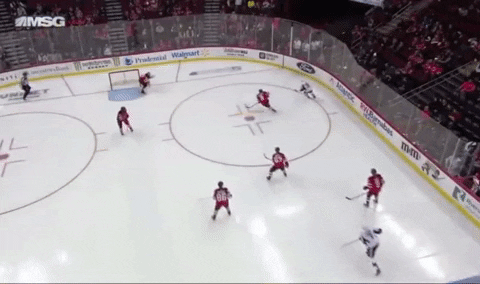As we covered in part 1, backchecking is an important part of the game and needs to be clearly defined.
Many of the best players are able to turn back checking into possession and offense for their team.
In part 2, we are going to cover 2 common issues when backchecking.
Over-backchecking
Puck Gravity
Issue 1: Over-Backchecking
Simply put, over-backchecking is when a team is so concerned about coming back hard to defend the rush that they all go too far into their own zone. Example (yellow jerseys):
It’s more common than you’d originally think.

The NJ Devils give us a perfect example where players are so concerned about getting back that they forget about the high ice.
Sometimes an over-backcheck is outright, hilariously comical. You don’t need to be a defensive or hockey expert to understand this was poor:
Issue 2: Puck Gravity
Puck gravity is where 2 or more are covering the 1 puck carrier.
Again, sometimes this can get outright comical (I think we can safely give the goalie a “pass” on this goal against:
The puck acts as a gravitational force. The defending team goes to the puck and puck carrier instead of stopping in a quality spots and picking up the passing options.
Solutions
As mentioned in part 1, communication and understanding of roles is important from a team tactic perspective.
From an individual tactic perspective there are a few key items to be a great backchecker.
Backchecking through the middle of the ice
Backchecking to a quality spot and stopping
Shoulder checking to understand the unfolding situation
Covering opposing players that could be passing options for the puck carrier. Personally, I call this “suffocating the passing options.”
Here is an example of a backcheck to the slot, stopping in a quality spot, and being able to deter a chance. This is part of the transformation from Auston Matthews that makes him one of the elite 2-way centers in the NHL.
In hockey, the smallest details matter. There is more luck involved than people want to admit. Having solid backchecking habits to put luck on your side more often is a big deal.
Further reading - How Auston Matthews has transformed his defensive game to become an elite 200-foot NHL center
Did you enjoy this newsletter?
Help us spread the ideas within and share it with the people you care about









